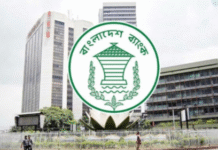The amount of foreign aid in the closing pipeline crossed US$ 15 billion at the end of the last fiscal year (2011-12) apparently because of the slow implementation of projects that leads to slow disbursement of foreign aid.
The pipeline amount stood at 15.4 billion that was 11.29 percent higher than that of the previous year (2010-11).
The fiscal year 2011-2012 began with an opening pipeline of about US$ 13.86 billion, according to the recent flow of external resources released by the Economic Relations Division (ERD).
The ERD figures showed that the new commitment during the period amounted to US$ 4.76 billion.
The total disbursement during FY 2011-2012 amounted to about US$ 2.13 billion, which was also 19.7 percent higher than the disbursement of the previous year.
The overall disbursement of foreign aid channelled through ERD as a percentage of pipeline opening balance is near 15.34 percent, which is lower than the average of 21.3 percent.
Talking to UNB, eminent economist Dr Mustafa Kamal Mujeri said it is commonly known by all about the slow pace of aid utilisation in Bangladesh.
He said the implementation rate of the Annual Development Programme (ADP) in the country is not up to the mark and the commitment of aid in the pipeline is increasing day by day. “If foreign aid cannot be utilised effectively, then the run-over cost increases.”
Since the country has resource constraints, the Director General of the Bangladesh Institute of Development Studies (BIDS), also stressed the need for enhancing the capacity of aid utilisation by different ministries, divisions and executing agencies to reap the benefits of aid.
Dr Mujeri also said if aid in the pipeline could be utilised properly, the disbursement would increase and it would positively affect the country’s development programmes and thus increase the growth.
An official at the ERD said the slow implementation of project results in slow disbursement of aid, which leads to time and cost overrun.
He also said it impacts negatively the balance of payments leading to increased borrowing from domestic sources.
According to the flow of external resources up to June 30, 2012, projects are often designed without proper planning or feasibility studies. People also engaged in the project preparation are not properly trained.
“In many cases, faulty design of the project leads to a revision of the Development Project Proposal (DPP)/Technical Project Proposal (TPP) even before commencement of the project,” it said.
Besides, lengthy approval process of the DPPs/TPPs takes longer time to start the projects. Sometimes, projects are not adequately staffed with right kind of people. In many cases, project personnel are transferred.
According to the recent flow of external resources, a total of about US$ 75.19 billion of external assistance was committed to Bangladesh.
As per the classification by purposes, the share of food aid is US$ 6.88 billion, commodity aid US$ 11.07 billion, project aid US$ 53.97 billion and budget support is US$ 3.27 billion of the total commitments.
For the period since independence up to June 30, 2012, a total amount of about US$ 56.5 billion of foreign aid was disbursed, of which US$ 23.93 billion was grant and US$ 32.57 billion in loan.
Of the total amount, US$ 6.71 billion came as food aid, US$ 10.91 billion as commodity aid, US$ 35.96 billion as project aid and US$ 2.92 billion as budget support. The per capita debt obligation of the country has risen from US$ 6.59 in 1973-74 to US$ 155.3 in 2011-12.
Source: UNB Connect










